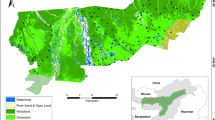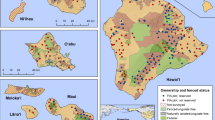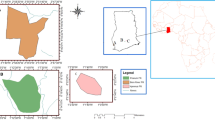Abstract
Context
Invasive plants cause significant impacts in forested areas throughout the world. However, little is known about the relative importance of environmental drivers on the establishment and spread of invasive plants across forests at broader spatial scales.
Objectives
We evaluated which factors are more closely associated with successful plant invasions across southern United States (US) forests and predicted regional susceptibility to invasion by 16 known major invasive plant taxa.
Methods
We compiled environmental variables and presence-absence data for invasive plants across 52,690 southern US forestland plots surveyed by the Forest Inventory and Analysis (FIA) program of the USDA Forest Service. We used an ensemble species distribution modeling approach to model the potential distribution of the invasive plants and evaluated effects of the environmental predictors on species occurrences.
Results
Invasive species presence was favored by proximity to land use such as pastures, croplands, and developed areas, as well as by high light availability and soil capacity to retain nutrients and water. Soil organic matter was negatively correlated with invasive species presence. However, the effect of climatic variables and other soil properties, such as pH and soil depth, was species-specific.
Conclusions
Climate, land use, and soil organic matter were important but varied in their influence on invasive species distributions. Our results also indicate that most of our focal invasive plants are likely to occupy large forested areas throughout the study region. Thus, estimates of invasion risk should be incorporated into conservation strategies to prevent further establishment of invasive plants in forested areas.





Similar content being viewed by others
Data availability
All the relevant data for the article can be found in Tables, Figures, and Supplementary Tables and Figures.
References
Allouche O, Tsoar A, Kadmon R (2006) Assessing the accuracy of species distribution models: prevalence, kappa and the true skill statistic (TSS). J Appl Ecol 43:1223–1232
Anderson DP, Turner MG, Pearson SM, Albright TP, Peet RK, Wieben A (2013) Predicting Microstegium vimineum invasion in natural plant communities of the southern Blue Ridge Mountains, USA. Biol Invasions 15:1217–1230
Araújo MB, New M (2007) Ensemble forecasting of species distributions. Trends Ecol Evol 22:42–47
Arif F, Akbar M (2005) Resampling air borne sensed data using bilinear interpolation algorithm. IEEE ICM 2005:62–65
Beaury EM, Finn JT, Corbin JD, Barr V, Bradley BA (2019) Biotic resistance to invasion is ubiquitous across ecosystems of the United States. Ecol Lett 23:476–482
Booth BD, Murphy SD, Swanton CJ (2003) Weed ecology in natural and agricultural systems. CACI, Wallingford
Booth TH, Nix HA, Busby JR, Hutchinson MF (2014) BIOCLIM: the first species distribution modelling package, its early applications and relevance to most current MAXENT studies. Divers Distrib 20:1–9
Bradie J, Leung B (2017) A quantitative synthesis of the importance of variables used in MaxEnt species distribution models. J Biogeogr 44:1344–1361
Bradley BA, Wilcove DS, Oppenheimer M (2010) Climate change increases risk of plant invasions in the eastern United States. Biol Invasions 12:1855–1872
Brown RN, Sawyer CD (2012) Plant species diversity of highway roadsides in Southern New England. Northeast Nat 19:25–42
Cabin RJ, Mitchell RJ (2000) To Bonferroni or not to Bonferroni: when and how are the questions. Bull Ecol Soc Am 81:246–248
Capinha C, Essl F, Seebens H, Moser D, Pereira HM (2015) The dispersal of alien species redefines biogeography in the Anthropocene. Science 348:1248–1251
Carter GA, Teramura AH (1988) Vine photosynthesis and relationships to climbing mechanics in a forest understory. Am J Bot 75:1011–1018
Catford JA, Jansson R, Nilsson C (2009) Reducing redundancy in invasion ecology by integrating hypotheses into a single theoretical framework. Divers Distrib 15:22–40
Catford JA, Vesk PA, White MD, Wintle BA (2011) Hotspots of plant invasion predicted by propagule pressure and ecosystem characteristics. Divers Distrib 17:1099–1110
Chapman AD, Muñoz ME, Koch I (2005) Environmental information: placing biodiversity phenomena in an ecological and environmental context. Biodivers Inform 2:24–41
Chapman D, Purse BV, Roy HE, Bullock JM (2017) Global trade networks determine the distribution of invasive non-native species. Glob Ecol Biogeogr 26:907–917
Crooks JA (2005) Lag times and exotic species: the ecology and management of biological invasions in slow–motion. Ecoscience 12:316–329
Davis MA, Grime JP, Thompson K (2000) Fluctuating resources in plant communities: a general theory of invasibility. J Ecol 88:528–534
Diez JM, Pulliam HR (2007) Hierarchical analysis of species distributions and abundance across environmental gradients. Ecology 88:3144–3152
Dormann CF, Elith J, Bacher S, Buchmann C, Carl G, Carré G, Marquéz JRG, Gruber B, Lafourcade B, Leitão PJ, Münkemüller T, McClean C, Osborne PE, Reineking B, Schröder B, Skidmore AK, Zurell D, Lautenbach S (2013) Collinearity: a review of methods to deal with it and a simulation study evaluating their performance. Ecography 36:27–46
Elton C (1958) The ecology of invasions by animals and plants. Methuen, London
Environmental Systems Research Institute (ESRI) (2018) ArcGIS Desktop ArcGIS 10.5.1. Redlands, CA, USA. Accessed 19 Sept 2019
Ficetola GF, Thuiller W, Miaud C (2007) Prediction and validation of the potential global distribution of a problematic alien invasive species–the American bullfrog. Divers Distrib 13:476–485
Fick SE, Hijmans RJ (2017) Worldclim 2: New 1–km spatial resolution climate surfaces for global land areas. Int J Climatol 37:4302–4315
Franklin J (2009) Mapping species distributions: spatial inference and prediction. Cambridge University Press, Cambridge
Friedman J, Hastie T, Tibshirani R (2000) Additive logistic regression: a statistical view of boosting (with discussion and a rejoinder by the authors). Ann Stat 28:337–407
Guisan A, Thuiller W, Zimmermann NE (2017) Habitat Suitability and Distribution Models. Cambridge University Press, Cambridge
Guo Q, Riitters KH, Potter KM (2018) A subcontinental analysis of forest fragmentation effects on insect and disease invasion. Forests 9:744
Gurevitch J, Scheiner SM, Fox GA (2002) The ecology of plants. Sinauer Associates, Sunderland
Hastie TJ, Tibshirani RJ (1990) Generalized additive models. CRC, Boca Raton
Homer CG, Dewitz JA, Yang L, Jin S, Danielson P, Xian G, Coulston J, Herold ND, Wickham JD, Megown K (2015) Completion of the 2011 National Land Cover Database for the conterminous United States-Representing a decade of land cover change information. Photogramm Eng Rem S 81:345–354
Hulme PE (2009) Trade, transport and trouble: managing invasive species pathways in an era of globalization. J Appl Ecol 46:10–18
Iannone BV, Oswalt CM, Liebhold AM, Guo Q, Potter KM, Nunez-Mir GC, Oswald SN, Pijanowski BC, Fei S (2015) Region‐specific patterns and drivers of macroscale forest plant invasions. Divers Distrib 21:1181–1192
Iannone BV, Potter KM, Hamil KA, Huang W, Zhang H, Guo Q, Oswalt CM, Woodall CW, Fei S (2016) Evidence of biotic resistance to invasions in forests of the Eastern USA. Landscape Ecol 31:85–99
Ibáñez I, Silander JA Jr, Allen JM, Treanor SA, Wilson A (2009a) Identifying hotspots for plant invasions and forecasting focal points of further spread. J Appl Ecol 46:1219–1228
Ibáñez I, Silander JA, Wilson AM, LaFleur N, Tanaka N, Tsuyama I (2009b) Multivariate forecasts of potential distributions of invasive plant species. Ecol Appl 19:359–375
Jorge MLS, Galetti M, Ribeiro MC, Ferraz KMP (2013) Mammal defaunation as surrogate of trophic cascades in a biodiversity hotspot. Biol Conserv 163:49–57
Kaiser BA, Burnett KM (2010) Spatial economic analysis of early detection and rapid response strategies for an invasive species. Resour Energy Econ 32:566–585
Kebede F, Moehlman PD, Bekele A, Evangelista PH (2014) Predicting seasonal habitat suitability for the critically endangered African wild ass in the Danakil, Ethiopia. Afr J Ecol 52:533–542
Kelly R, Leach K, Cameron A, Maggs CA, Reid N (2014) Combining global climate and regional landscape models to improve prediction of invasion risk. Divers Distrib 20:884–894
Lázaro-Lobo A, Ervin GN (2019) A global examination on the differential impacts of roadsides on native vs. exotic and weedy plant species. Glob Ecol Conserv 17:e00555
Lázaro-Lobo A, Ervin GN (2020) Native and exotic plant species respond differently to ecosystem characteristics at both local and landscape scales. Biol Invasions 23:143–156
Lázaro-Lobo A, Evans KO, Ervin GN (2020) Evaluating landscape characteristics of predicted hotspots for plant invasions. Invasive Plant Sci Manag 13:163–175
Lázaro-Lobo A, Lucardi R, Ramirez-Reyes C, Ervin GN (2021) Region-wide assessment of fine-scale associations between invasive plants and forest regeneration. For Ecol Manag 483:118930
Lemke D, Hulme PE, Brown JA, Tadesse W (2011) Distribution modelling of Japanese honeysuckle (Lonicera japonica) invasion in the Cumberland Plateau and Mountain Region, USA. For Ecol Manag 262:139–149
Levine JM, Vila M, D’Antonio CM, Dukes JS, Grigulis K, Lavorel S (2003) Mechanisms underlying the impacts of exotic plant invasions. P Roy Soc B-Biol Sci 270:775–781
Liu C, White M, Newell G (2013) Selecting thresholds for the prediction of species occurrence with presence-only data. J Biogeogr 40:778–789
Lockwood JL, Cassey P, Blackburn T (2005) The role of propagule pressure in explaining species invasions. Trends Ecol Evol 20:223–228
Lucardi RD, Bellis ES, Cunard CE, Gravesande JK, Hughes SC, Whitehurst LE, Worthy SJ, Burgess KS, Marsico TD (2020) Seeds attached to refrigerated shipping containers represent a substantial risk of nonnative plant species introduction and establishment. Sci Rep 10:15017
Lucas RE, Davis JF (1961) Relationships between pH values of organic soils and availabilities of 12 plant nutrients. Soil Sci 92:177–182
Milbau A, Stout JC, Graee BJ, Nijs I (2009) A hierarchical framework for integrating invasibility experiments incorporating different factors and scales. Biol Invasions 11:941–950
Miller JH, Lemke D, Coulston J (2013) The invasion of southern forests by nonnative plants: current and future occupation, with impacts, management strategies, and mitigation approaches. In: Wear DN, Greis JG (eds) The southern forest futures project: technical report. General technical report 178. USDA-Forest Service, Southern Research Station, Asheville, pp 397–456
Müller-Schärer H, Steinger T (2004) Predicting evolutionary change in invasive, exotic plants and its consequences for plant-herbivore interactions. In: Ehler LE, Sforza R, Mateille T (eds) Genetics evolution and biological control. CAB International, Wallingford, pp 137–162
Multi-Resolution Land Characteristics Consortium (2019) NLCD 2016 (CONUS). Available at https://www.mrlc.gov/data
Oswalt SN, Oswalt CM (2011) The extent of selected nonnative invasive plants on southern forest lands, in: Fei S, Lhotka JM, Stringer JW, Gottschalk KW, Miller GW (eds) Proceedings, 17th central hardwood forest conference, Gen. Tech. Rep. NRS-P-78. US Department of Agriculture, Forest Service, Northern Research Station, Lexington, pp 447–459
Oswalt CM, Fei S, Guo Q, Iannone BV III, Oswalt SN, Pijanowski BC, Potter KM (2015) A subcontinental view of forest plant invasions. NeoBiota 24:49–54
Parker JD, Richie LJ, Lind EM, Maloney KO (2010) Land use history alters the relationship between native and exotic plants: the rich don’t always get richer. Biol Invasions 12:1557–1571
Pattison, Mack RN (2008) Potential distribution of the invasive tree Triadica sebifera (Euphorbiaceae) in the United States: evaluating CLIMEX predictions with field trials. Glob Chang Biol 14:813–826
Pauchard A, Alaback PB (2004) Influence of elevation, land use, and landscape context on patterns of alien plant invasions along roadsides in protected areas of south-central Chile. Conserv Biol 18:238–248
Peltzer DA, Allen RB, Lovett GM, Whitehead D, Wardle DA (2010) Effects of biological invasions on forest carbon sequestration. Glob Change Biol 16:732–746
Peterson AT, Soberón J, Pearson RG, Anderson RP, Martinez-Meyer E, Nakamura M, Araujo MB (2011) Ecological niches and geographic distributions. Princeton University Press, Princeton
Phillips SJ (2017) A Brief Tutorial on Maxent. AT&T Research. Available at http://biodiversityinformatics.amnh.org/open_source/maxent/. Accessed 15 Aug 2020
Phillips SJ, Anderson RP, Schapire RE (2006) Maximum entropy modeling of species geographic distributions. Ecol Modell 190:231–259
Planty-Tabacchi A, Tabacchi E, Naiman R, Deferrari C, Dicamps H (1996) Invasibility of species-rich communities in riparian zones. Conserv Biol 10:598–607
R Core Team (2019) R: A language and environment for statistical computing. R Foundation for Statistical Computing, Vienna, Austria. URL https://www.R-project.org/. Accessed 19 Sept 2019
Ramirez-Reyes C, Street G, Vilella FJ, Jones-Farrand DT, Wiggers MS, Evans KO (2021) Ensemble species distribution model identifies survey opportunities for at-risk bearded beaksedge (Rhynchospora crinipes) in the southeastern United States. Nat Areas J 41:55–63
Reaser JK, Burgiel SW, Kirkey J, Brantley KA, Veatch SD, Burgos-Rodríguez J (2020) The early detection of and rapid response (EDRR) to invasive species: a conceptual framework and federal capacities assessment. Biol Invasions 22:1–19
Riitters K, Potter K, Iannone BV III, Oswalt C, Fei S, Guo Q (2018) Landscape correlates of forest plant invasions: a high-resolution analysis across the eastern United States. Divers Distrib 24:274–284
Rouget M, Richardson DM (2003) Inferring process from pattern in plant invasions: a semimechanistic model incorporating propagule pressure and environmental factors. Am Nat 162:713–724
Säumel I, Kowarik I (2010) Urban rivers as dispersal corridors for primarily wind-dispersed invasive tree species. Landscape Urban Plan 94:244–249
Shea K, Chesson P (2002) Community ecology theory as a framework for biological invasions. Trends Ecol Evol 17:170–176
Sofaer HR, Hoeting JA, Jarnevich CS (2019) The area under the precision-recall curve as a performance metric for rare binary events. Methods Ecol Evol 10:565–577
Soil Survey Staff (2020) The Gridded Soil Survey Geographic (gSSURGO) Database. United States Department of Agriculture, Natural Resources Conservation Service. Available at https://www.nrcs.usda.gov/. Accessed 10 Sept 2019
Theoharides KA, Dukes JS (2007) Plant invasion across space and time: factors affecting nonindigenous species success during four stages of invasion. New Phytol 176:256–273
U.S. Geological Survey (2020) The National Map. U.S. Department of the Interior. Available at https://www.nationalmap.gov. Accessed 19 Sept 2019
USDA NRCS (2020) The PLANTS Database (http://plants.usda.gov, 31 May 2020). National Plant Data Team, Greensboro, NC 27401–4901 USA
USFS USDA Forest Service (2018) FIA Database Description and User Guide for Phase 2 (version: 8.0). USDA Forest Service, Forest Inventory and Analysis National Office
USFS USDA Forest Service (2020) United States Forest Service. United States Department of Agriculture. https://www.fs.usda.gov/r8. Accessed 20 Sept 2020
Walker GA, Robertson MP, Gaertner M, Gallien L, Richardson DM (2017) The potential range of Ailanthus altissima (tree of heaven) in South Africa: the roles of climate, land use and disturbance. Biol Invasions 19:3675–3690
Wang HH, Grant WE (2012) Determinants of Chinese and European privet (Ligustrum sinense and Ligustrum vulgare) invasion and likelihood of further invasion in southern US forestlands. Invasive Plant Sci Manag 5:454–463
West AM, Kumar S, Brown CS, Stohlgren TJ, Bromberg J (2016) Field validation of an invasive species Maxent model. Ecol Inform 36:126–134
Yang S, Fan Z, Liu X, Ezell AW (2021) Predicting the spread of Chinese tallow (Triadica sebifera) in the southeastern United States forestland: Mechanism and risk factors at the regional scale. For Ecol Manag 482:118892
Zimmermann NE, Yoccoz NG, Edwards TC, Meier ES, Thuiller W, Guisan A, Schmatz DR, Pearman PB (2009) Climatic extremes improve predictions of spatial patterns of tree species. Proc Natl Acad Sci 106:19723–19728
Zuur A, Ieno EN, Walker N, Saveliev AA, Smith GM (2009) Mixed effects models and extensions in ecology with R. Springer, New York
Acknowledgements
We sincerely appreciate the effort from numerous hard-working state and federal individuals for surveying the FIA plots. Additionally, we are grateful to Jeffery Turner and William Watkins from the USDA Forest Service, Southern Research Station, Forest Inventory & Analysis Unit, Knoxville, TN, for providing invaluable assistance in accessing FIA data. We also thank Anna Grossman (USFS, Southern Region, State & Private Forestry, Forest Health Protection) who sponsored the Environmental Monitoring Program award within the Region’s Forest Health Protection program-areas. This research was supported by the United States Department of Agriculture, Forest Service, Southern Research Station and the Environmental Monitoring program award 19-DG11083150-006 to GNE & RDL.
Funding
This research was supported, in part, by the United States Department of Agriculture, Forest Service, Southern Research Station and the Environmental Monitoring program award 19-DG11083150-006 to GNE & RDL. This research was, in part, conducted by a USDA research scientist (RDL) on official time, and is therefore, in the public domain. This research does not represent any official policy declarations on behalf of the USDA.
Author information
Authors and Affiliations
Contributions
ALL: Conceptualization, Methodology, Software, Validation, Formal analysis, Investigation, Data Curation, Writing - Original Draft, Writing - Review & Editing, Visualization, Funding acquisition. CRR: Conceptualization, Methodology, Software, Validation, Formal analysis, Data Curation, Writing - Review & Editing, Visualization. RDL: Conceptualization, Methodology, Validation, Resources, Writing - Review & Editing, Visualization, Supervision, Funding acquisition. GNE: Conceptualization, Methodology, Validation, Resources, Writing - Review & Editing, Visualization, Supervision, Funding acquisition.
Corresponding author
Ethics declarations
Conflict of interest
Not applicable.
Consent for publication
The authors give the publisher the permission to publish this work.
Additional information
Publisher’s Note
Springer Nature remains neutral with regard to jurisdictional claims in published maps and institutional affiliations.
Supplementary Information
Below is the link to the electronic supplementary material.
Rights and permissions
About this article
Cite this article
Lázaro-Lobo, A., Ramirez-Reyes, C., Lucardi, R.D. et al. Multivariate analysis of invasive plant species distributions in southern US forests. Landscape Ecol 36, 3539–3555 (2021). https://doi.org/10.1007/s10980-021-01326-3
Received:
Accepted:
Published:
Issue Date:
DOI: https://doi.org/10.1007/s10980-021-01326-3




